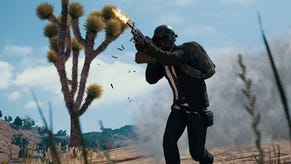PUBG Xbox One patch analysis: two steps forward, one step back
Frame-rates improve, but performance is still poor overall - and netcode quality takes a hit.
One week on from its controversial launch, the Xbox One version of PlayerUnknown's Battlegrounds has been patched, featuring a range of bugfixes and what the patch notes describe as a 'first pass' at visual and performance improvements, along with 'slightly improved' anti-aliasing. So what's actually changed? From our perspective, this patch is definitely a case of two steps forward, one step back.
PUBG is an inherently dynamic game, which makes like-for-like performance analysis from one version of the game to the next practically impossible, so all we can offer are some more general observations. As with our first test, we played the game simultaneously on Xbox One and Xbox One X, buddying up in the lobby area and negotiating various games as a team, capturing our progress in tandem. The truth is, the variable nature of PUBG changes from game to game, from moment to moment, but at least using this technique, we have both consoles running from the same server, usually rendering very similar workloads.
One thing that does stand out straight away is that while the visual quality is still poor, the vast gulf in texture quality between the standard and X units seems to have lessened this time around, though bad quality art is still in abundance on both systems with incidental detail - like ground debris - reduced to a cluster of barely filtered pixels. Anti-aliasing does look different - most notably on the base Xbox One - where the blurry nature of the filter has been dialled back, giving a crisper look.
But it's performance that's the key point in need of improvement, and while we can say that frame-rate averages have improved from the launch code to this week's patch, there are still profound issues. PUBG still has a tendency to kick off with poor frame-rates from the lobby to the parachute drop-off, only stabilising minutes later into gameplay at the required 30fps. But there are still random issues that send performance plummeting and an abundance of foliage still seems to cause problems. Xbox One X now seems more able get a better lock on the target performance level, while the standard model is clearly more prone to dropping hard at stress points. Meanwhile, some areas of the map still cause issues, while high-speed traversal in a vehicle also causes choppiness on both systems. Across our tests, we've also had a couple of freezes, leading to crashes to the console front-end (thankfully you can jump straight back into the server you crashed out of).
But the biggest issue we've encountered in returning to PUBG is that netcode is far less stable than it was during the launch last week. According to some of our followers on Twitter, micro-teleporting and 'rubber-banding' started to occur before Patch 1 was deployed, but it definitely persists into the new version. Again, this can seemingly happen at any given point, but occurs most often at the beginning of the game. At its worst, we get network connection blackouts, but the inability to simply walk through a door is commonplace at the time of writing. Based on our experiences, the issue kicks in most noticeably when other players are present - which is obviously less than ideal, as that's when control really shouldn't be compromised. As things stand, the experience, as fun as it can be, is still frustrating enough to make paying for the product a big ask.
Input latency also feels unchanged from when we first played it. Thanks to Nigel Woodall and his innovative controller lag monitoring set-up, we have some measurements here - and they're not great. Across a range of tests using multiple weapons, the time from button press to result on-screen is eight to nine frames - 133ms to 150ms. When the game isn't running at 30fps, you can expect further latency on top of that, plus whatever lag your display adds. For a first-person shooter, the lowest possible latency is essential and given the 30fps limit, the developers should be aiming for a realistic 83-100ms as the target here. In short, there's a long way to go in getting PUBG into shape - and it's not just about the graphics and the netcode, as crucial as they are.
Having played both the initial release and the updated version now, we're conflicted about this title. There's no doubt that the concept and many aspects of the execution are excellent - and despite the array of issues, every time we play it, we have a great deal of fun. However, the mass of technical problems makes the concept of paying £25/$30 for the game difficult to swallow. Yes, it's early access, but at the same time, it's difficult to understand why the game didn't receive any kind of public access beta when it so obviously needed it. It could have provided the developer with useful information in optimising the game before launch, while users would get a chance to sample the current state of the game before forking out the money for what is obviously very early code.
And at the same time, with Microsoft so closely involved with the title, we do have to wonder where the threshold is now with quality control. Is slapping 'Game Preview Edition' on a retail box enough to justify shipping out a game that's poor in so many respects and surely wouldn't make it past the QA procedures required of a standard game? Are the micro-teleporting and 'rubber-banding' issues acceptable when an Xbox Live Gold subscription is still required to play the game? Optimistically, there's months of work required on the Xbox One version of PUBG, so as brilliant as the concept is, our advice for now is to hold fire until its many teething issues are more comprehensively addressed.


















